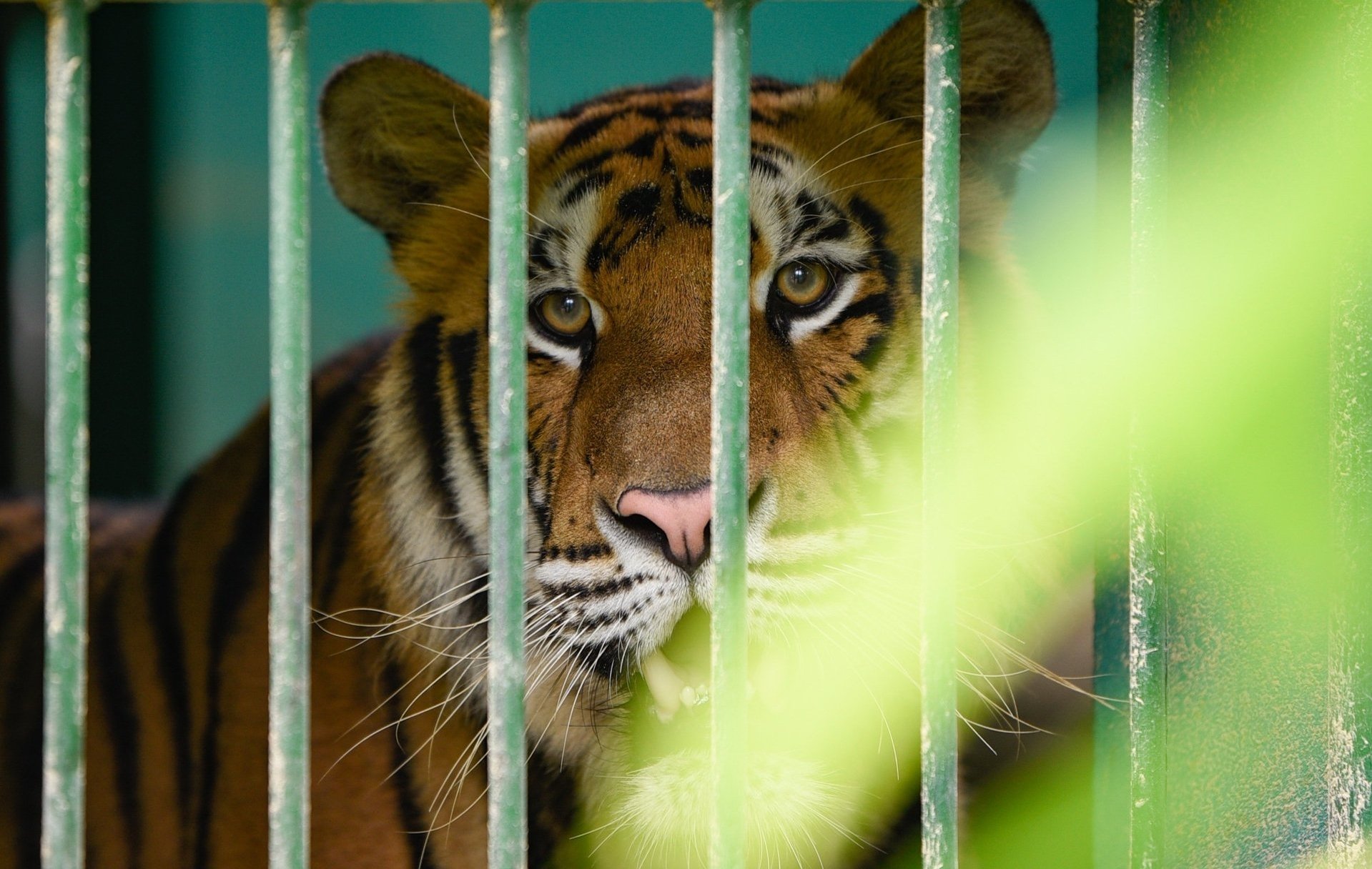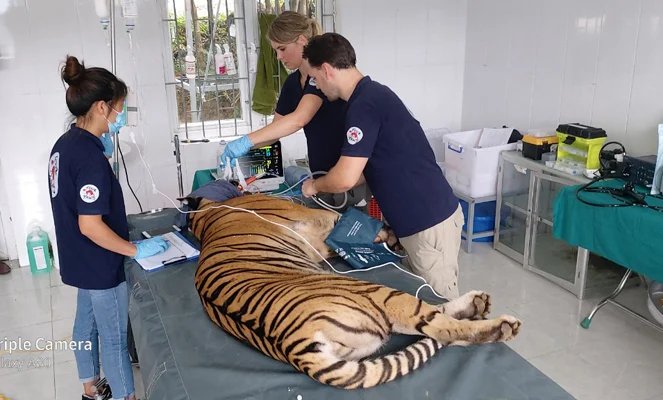November 23, 2025 | 04:17 GMT +7
November 23, 2025 | 04:17 GMT +7
Hotline: 0913.378.918
November 23, 2025 | 04:17 GMT +7
Hotline: 0913.378.918

Each tiger has its pattern of stripes, like fingerprints in humans. Photo: Tung Dinh.
Many reasons are causing the severe decline in tiger numbers in Vietnam in particular and the world in general, according to Mr. Tran Ngoc Anh, Deputy Director of the Center for Rescue, Conservation and Development of Organisms, Phong National Park. Nha-Ke Bang.
He listed some main reasons, emphasizing illegal hunting, trade, and the decline in habitat and food sources of tigers.
Tiger skin is considered a precious commodity in many countries. Illegal hunters aggressively hunt tigers for their skins. Many people want to buy other parts of the tiger's body to make medicine.
In addition, poachers also kill many animals that are prey for tigers, such as deer, roe deer, wild boars, and wild goats. That situation causes the household's food supply to decline.
Another obstacle to preserving Indochinese tigers is the gradual loss of their habitat as farmers take land for farming and forests are cleared to build roads, dams, and mines. The ever-shrinking forest area causes tigers to be forced into more miniature woods, where their fate becomes more fragile.
"Tigers are at the top of the food chain. Any change in the food chain will affect them, making them unable to adapt," Mr. Ngoc Anh said.
An adult Indochinese tiger can move up to 60km a day. Creating an ideal living space for them is tricky.
Mr. Ngoc Anh took the example of Phong Nha-Ke Bang National Park itself. In previous years, when many grasslands existed, tigers often found their way home. But over time, vegetation has decreased, making it very difficult to see tigers in the wild.
"To restore the environment for tigers, it is necessary to restore ungulate herbivores simultaneously, which are the main food source for tigers. To maintain herbivores, we must first create large grasslands and a living environment for them," Mr. Ngoc Anh analyzed.
To preserve Indochinese tigers, the tiger expert commented, it is necessary to protect the integrity of their habitat ecologically so that not only tigers but also wild animals in general can recover.
Many studies have been conducted and implemented in the park, such as zoning habitats where tigers can live to monitor and monitor their appearance, especially the border area extending from Thuong Trach commune, Bo Trach district, towards the Annamite Range.
In addition to the efforts of countries with tigers, international organizations must join hands to create an area large enough for tigers to live like decades ago, according to Mr. Ngoc Anh.

Tigers like to eat pigs, deer and buffalo but are also willing to catch smaller animals, such as rabbits. Photo: H.Tri.
Besides cooperating with the Animals Asia Foundation, Phong Nha–Ke Bang National Park also receives strong FAO support. This organization has sent many experts to take care of them, periodically check their health, support the relocation of tigers, and give recommendations on caring for, nurturing, and gradually improving their living environment.
On the Vietnamese side, Mr. Ngoc Anh proposed that the Government build a legal framework and documents, including reviewing regulations to create a strict management regime and prioritize investing in Indochinese tiger conservation.
Besides, local authorities need to strengthen law enforcement. If necessary, some cases related to illegal hunting and transportation of Indochinese tigers must be strictly handled to act as a deterrent.
Mr. Ngoc Anh wishes to receive more support to build a giant database on Indochinese tigers. To collect such data techniques such as radio collars and capture-recapture population estimation models have been used to collect population numbers.
To specify, "tiger searching" is a primary method that involves either riding elephants or driving off-road vehicles into tiger territory and identifying individuals and their locations. The pugmark census technique is also used during these travels. This involves observing paw prints in the ground and taking measurements of width, length, and indentation to determine the individual in the location.
Another method, referred to as "camera traps," involves setting up surveying cameras that activate when movement is detected and will spontaneously take multiple photographs of the area. Reserve management does not often use camera traps due to their expense and the need for trained personnel to operate the equipment. Still, they are becoming more common in tiger research due to their accuracy.
Capture-recapture models are now commonly used in conjunction with tiger tracking. They not only measure population numbers but also measure demographic parameters. This combination technique includes camera traps and basic tiger searches to collect sufficient data. Once researchers and conservation biologists can gain knowledge of the population and its numbers, conservation efforts are put to work.
Translated by Tuan Huy

(VAN) Results from the Sustainable Durian Model Project in Dak Lak have confirmed the critical role of Yara Viet Nam in transferring advanced nutritional solutions to farmers.

(VAN) In Tuyen Quang province, livestock farmers have introduced effective models and innovative practices that significantly strengthen African Swine Fever prevention and control efforts.

(VAN) This is the study conducted by IRRI and Can Tho University on the rice straw value chain in Mekong Delta showing an economic potential of more than 6.6 trillion VND/year.

(VAN) By participating in cooperative economics, many farmers in Tay Ninh have overcome hardship, mastered clean dragon fruit cultivation techniques.

(VAN) The crossbreeding program in the former Binh Dinh province (now part of Gia Lai) has shown signs of decline, and urgent measures are needed to revive it and sustain past achievements.

(VAN) The agricultural sector agreed on a roadmap to pilot the MRV protocol and expand low-emission rice production from the 2025-2026 winter-spring crop.

(VAN) Agricultural extension officers in Quang Ninh do more than transmit knowledge; they have become a steadfast support system for farmers on the path to sustainable agricultural development.